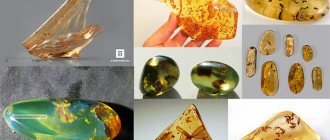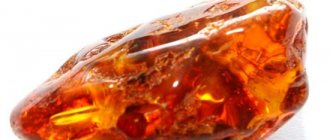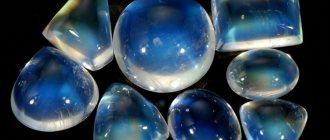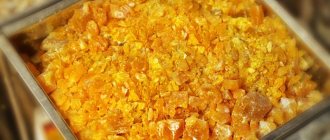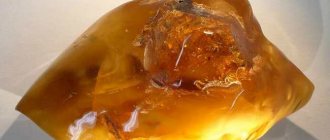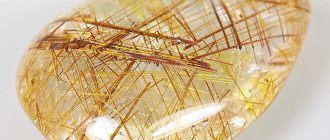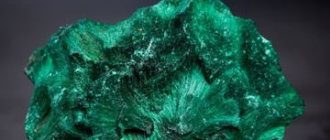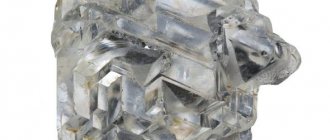Amber stone is also called “Gold of the Baltic” or Baltic amber
, because the largest deposits of amber are located on the coast of the Baltic Sea, near Kaliningrad, which is why the stone is also called “Kaliningrad amber”.
Today we will look at the beneficial properties of amber, learn its history and how many colors of the mineral exist in nature.
Photo: Kaliningrad amber
Description of the amber stone
There are golden, honey, brown-black shades and shades of ivory. The best specimens are considered to be stones of golden tones. The cognac-colored stone is in great demand among connoisseurs of sophistication. The mineral has healing properties, thanks to which a wide range of diseases can be treated.
The physical properties of amber are not similar to any stone of organic origin:
- The density of amber, which is comparable to sea water, allows it not to sink in salt water.
- If you immerse it in 100ºC hot water, it will become soft.
- It is completely destroyed in nitric acid.
- Under the influence of external factors, it changes color and density.
- When it comes into contact with woolen fabric, it becomes electrified.
- Depending on its transparency when exposed to ultraviolet rays, it luminesces.
It is the presence of these properties that means that it is not a fake. Everyone knows how many beneficial properties the “Solar Gem” has. The properties of amber stone are diverse and are widely used in many industries. According to its physical and chemical properties, this mineral has different shapes, colors and differs in the degree of transparency.
There are many legends about amber. The meaning of the stone has been known to man since ancient times, and the history of amber begins with the Neolithic era. It has a large number of names such as “Tear of the Sea”, “Gift of the Sun” electron, “Solar Gem” and others.
Distinctive features
This gem is soft - up to 2.5 Mohs units. It is easily scratched by glass or a knife, has a low density, and is therefore lightweight. It burns and melts at a temperature of about 200 degrees, while emitting a characteristic pine-clove smell. There are variations in the degree of transparency of the stone - transparent, translucent, opaque (the so-called bone). The latter is not valued in its pure form, so it is processed and melted to produce “reconstructed” amber, which will be transparent.
Simple methods to distinguish natural amber:
- Visual. Check the stone for light: natural iletra consists of wave-like “swells” of mass, which occurred due to the fact that liquid floated onto the already hardened resin. Artificial stone does not have this effect.
- Visually, you can distinguish a fake from ambroids - by the shape of the bubbles. The air bubbles in it will be elongated, while in a natural gem they will be spherical. The texture of the product becomes “mosaic”, kaleidoscopic. But only low-quality imitations from “reconstructed” amber are identified in this way; high-quality ones are more difficult to recognize.
- By smell. Copal, epoxy resin or plastic melts at the same temperature as amber, but has a different odor. Heat the needle or nail and touch the suspicious item in an inconspicuous place (so as not to spoil it). Synthetics will emit a characteristic pungent smell, copal, cowrie and dammar - the smell of medicine (like in a hospital), natural gem - a pleasant pine-clove smell.
- By weight. Glass imitations are heavier than electrons, plastic ones are much lighter.
- By the ability to become electrified. Rub the item with a woolen cloth. Amber will then acquire a negative electrical charge and begin to attract light objects - for example, pieces of finely chopped paper. Copal, cowrie, glass and plastic do not have this property, but ambroid - ambroid cannot be determined in this way.
Varieties
Scientists divide it into more than two hundred varieties. The following classification is considered the most famous.
Succinites. This variety is considered the highest quality. Amber succinite is the most popular variety, characterized by the presence of high levels of succinic acid (dicarboxylic acid). These types of amber mainly come in orange, yellow, red, white or ivory shades. This particular variety is used to make jewelry and is called jewelry amber. Cognac amber with a honey glow transforms any piece of jewelry.
Gedanites. Due to the small volume of oxygen, it is a fragile organic combination. It does not contain dicarboxylic acid. This group does not have sufficient strength and is impossible to work with, as a result of which this type is called “rotten stone”.
Glessites. These varieties of amber are opaque amber that contains the slightest amount of impurities. They differ in red-brown, dark-brown and black-brown shades. Glessites are close to a variety of succinites.
Stantenites. They are fragile and opaque, have a black-brown tint.
Bockerites. A dark brown mineral with a high degree of strength.
Kiscellites. They have yellow or olive green shades.
Schraufits. A stone that is distinguished by blood-red or yellow-red tones.
Untreated stone looks unattractive. The rock from which this mineral is mined is called “blue earth.” Drop-shaped amber is found in the Dominican Republic and its description is as follows: it looks like frozen tears.
Typical methods for detecting fakes
Appearance
Take a close look at the sample. Real stone doesn't look perfect. It is formed over many years. During this time, fossil remains of living organisms and air penetrate inside. Therefore, small cracks and spherical bubbles appear.
You can recognize the authenticity of amber by its color. The color of natural stone varies from rich brown to yellowish. There are red, milky, slightly greenish specimens. Pebbles of other colors are fake. Read more about the stone in the article “Types and colors of amber.”
Take a closer look at the structure and internal pattern of the pebble. In a natural sample, changes in tone are always noticeable, and the pattern is chaotic. Beads with an identical internal pattern on each stone are synthetic.
Image courtesy of Amber Palace store
Price
In 2021, the average cost of 1 g of stone is 140 rubles. Natural stone from trusted manufacturers cannot be cheap. Especially if it contains inclusions. This example is rare and quickly falls into the hands of collectors. The specimen with a large insect is of particular value.
Souvenir shops offer a wide range of inclusion stones. They are inexpensive and most often are fake.
The price is affected by the location of extraction and the age of the stone. Decoration from the beginning of the last century can cost hundreds of thousands of rubles. If the seller has set a low price and talks about discounts, this is a fake.
Artificial stones fascinate with their beauty. But the real value of amber lies in its age and energy. Natural samples are millions of years old.
In Haiti, scientists found amber with a spider frozen inside. The insect lived on the territory of the republic 120 ml. years ago. A similar discovery was made after analyzing the spider's blood.
Weight and thermal conductivity
Beads made from natural stones look weighty, but they are lighter than artificial ones. Fakes made of glass and plastic are always heavier. Even if their size is smaller.
To distinguish real from artificial amber, hold it to your hand. The natural sample is warm to the touch. Glass or plastic stays cool for a long time.
Scratch the pebble
Now about how to distinguish amber from a fake by scratching. Natural nails cannot be damaged by a sharp nail. If you manage to leave a scratch, it means this is an artificial stone. For example, I was digging.
Lightly scratch the pebble with the tip of a knife. The natural sample will begin to crumble, and shavings will be removed from the synthetic fake. If there is no trace of a knife left on the stone, it is made of glass.
Salt procedure
Let's figure out how to check amber for authenticity at home using salt. But this method is used if the stone is not set in a precious metal or jewelry alloy.
Dissolve 8 tsp in a glass. table salt in 0.2 liters of cold water and lower the pebble. Natural amber will not sink in a salt solution. In this way, you can identify counterfeits made of glass, bernite, or bakelite.
If the decoration does not fit into the glass, take a larger container. But in this case, add so much salt so that some of the crystals do not dissolve and remain at the bottom.
But this text is not 100% reliable. In nature, samples with high densities are found. They will drown in the salt solution.
Stones are also tested using regular tap water. Pour 200 ml of liquid into a glass and lower the stone. The natural sample will fall down.
Electrostatics
You can determine the authenticity of amber at home using a piece of wool or silk. Rub the pebble firmly on the cloth, then hold it up to a small piece of paper. The natural pebble will become electrified and immediately attract the paper.
Plastic can also become electrified. But in her this feature is less pronounced.
Using this method, you can accurately guess a fake made from copal, which is passed off as “young” amber. It will not become electrified even with prolonged active friction against the wool.
Smell
Now about how to distinguish a fake using smell. Rub the stone vigorously against your palm to warm it up. If the sample is real, you will smell a subtle pine scent.
After strong friction, the surface of the copal jewelry will begin to stick to the skin. A fake plastic pebble will emit an unpleasant odor.
Solvent
Fake differs from natural amber in that it is unstable to solvents. Moisten a cotton pad with acetone, ethyl alcohol or ether and apply to the stone.
The natural pebble will remain unharmed, but the synthetic one will begin to deteriorate. The color will change and the surface will become dull or uneven. A common fake made from copal will deteriorate irrevocably.
Synthetic pebbles can withstand alcohol, but will be destroyed by acetone.
Do not hold the cotton wool with solvent on the pebble for more than 5 seconds. Due to excessive exposure to the drug, stains may appear even on a natural sample. Therefore, jewelers do not recommend removing dirt from a stone with a solvent. Read about common methods of cleaning stones here: “How to clean amber at home.”
The solvent will help identify ambroid - pressed amber. When it comes into contact with esters, it instantly becomes sticky.
Now you have learned how to distinguish pressed amber using acetone. Let's check the authenticity of the stone using an open fire.
Combustion
Hold the lighter to the stone for 3 seconds. A natural sample burns and boils at the point of contact with an open fire. If you keep the pebble on the fire for another 2 seconds, it will continue to burn.
This method will spoil the stone, but will help reliably determine its authenticity.
Burning amber emits black smoke.
There is a less traumatic method. Heat the needle over an open fire and apply it to the sample. White smoke will begin to rise from the natural stone and a pleasant smell of resin will appear.
The synthetic fake melts quickly and emits a pungent chemical smell.
Color spectrum
Jewelers distinguish more than eight hundred different shades, however, it is difficult to count exactly how many specific shades it has. The following are considered more popular among jewelers: opaque yellow, transparent yellow, white, green, blue and opaque black (jet).
White or light amber has powerful healing properties and has a high price. This species is called royal amber. Yellow transparent amber also has a fairly high level of healing properties. Yellow amber is often used to make rings and beads.
An opaque smoky look, which has streaks of different shades, is called landscape. Landscape amber is considered a sought-after type of mineral. Stones with a cherry tint are quite highly prized.
Blue is considered the rarest variety and differs in price range. Unlike other types, it is harder and more difficult to process. The color of amber is very diverse and you can even find pink shades.
Physico-chemical characteristics of amber
Amber is an amorphous framework polymer that does not form crystals. It is not characterized by birefringence, dispersion and pleochroism. Luminescence is bluish-white or yellow-green. The stone is flammable and can catch fire even from the flame of a match. When rubbed, it becomes electrified. Can be polished well. In air it quickly oxidizes (“aging of amber”), changes its color and becomes brittle.
History and Application
According to scientists, the “Solar Gem” was formed in nature as a result of the petrification of long-term resin from coniferous trees. The name of the stone comes from the Lithuanian word “Gintars”, and means “protector from diseases”.
Since ancient times, Aristotle assumed that its basis was the resin of coniferous trees. And later in the 18th century it was scientifically proven that this mineral is formed in exactly this way. The composition mainly contains pine resin from the Pinus succinifera family.
Often there are inclusions in the stone - these are insects or plants, which make it more unique and expensive. Sticking to the drops of resin, the insects died in the instantly hardening mixture, and the layered resin covered them entirely.
Scientists have found that on the site of the Baltic Sea there was a forest and during the glaciation a glacier descended onto the forest clearing, and as a result of thawing a sea was formed. Wood resin, in contact with sea sand, air, salt and water, formed royal amber. The largest amber was found off the coast of the Baltic Sea; it weighed up to 15 kg.
The use of amber includes a very wide range of different industries. It is often used in pharmaceuticals, medicine, chemical production, technology and many other fields. “Gift of the Sun” is widely used in the production of necklaces, umbrella handles, various artistic elements, and special smoking holders. Amber is a mineral that, thanks to its elasticity and astringency, can be easily processed and polished and perfectly retains its created shape.
How amber is mined and processed
The main extraction of amber is carried out in Russia - the country supplies up to 90% to the world market. A large deposit is located in the Kaliningrad region, where up to 300 tons of stone are mined per year. Small deposits have been discovered in Siberia, the Urals, and Sakhalin.
The Baltic countries have large reserves of amber. The main country producing it is Lithuania. The Baltic mineral is recognized as one of the highest quality.
In Ukraine, stone mining is carried out in the amber triangle with an area of more than 200 km2, which includes Rivne, Volyn, Kyiv, and Zhytomyr regions. Estimated reserves are about 1.5 thousand tons.
There are several amber deposits around the world that are of interest for development. They are located in the territories:
- Burma;
- Dominican Republic;
- Indonesia;
- America.
Amber is extracted in 2 ways:
- A powerful stream of water erodes the earth, which supposedly contains gems. This is an industrial method.
- Search in coastal waters. Many professional rock catchers go out to sea in diving suits immediately after a storm or during high waves.
Amber processing includes:
- Rip off. The stone is subjected to rough initial grinding.
- Open it up. The mineral is sawn into blanks.
- Molding. The blanks are given specific shapes.
- Grinding. The resulting figures, beads and other products are processed until they have a smooth surface.
- Polishing. The final stage gives the finished product a smooth finish.
Due to its fragility, the mineral is difficult to cut; it is mainly processed as a cabochon.
To impart transparency and change the yellow color to cherry, calcination is used. Minerals are immersed in sea sand and heated to a temperature of 200 °C. This kind of amber is called “hot” amber.
Large gems are rare, small stones are usually found. They are collected and pressed, resulting in large pieces of mineral. This is molded amber.
You can search for sunstone on your own on the shores of the Baltic Sea. Tips on how to find amber:
- waves throw up stones after a storm;
- you need to look not on the beach, but in heaps of algae;
- when it is windy, you can search in the coastal vegetation.
Found stones can be processed independently at home. Stages:
- Sanding with coarse sandpaper and a file. It's worth starting from the transparent side.
- The future product is given shape. The stone is wrapped in cloth, clamped in a vice and cut with a jigsaw or hacksaw.
- Sand with medium-sized sandpaper, then fine. They work without pressure.
- Polish the product with a piece of felt, felt or flannel. Before this, a couple of drops of odorless vegetable oil or GOI paste are applied to it.
Watch the program about stone mining:
Magic properties
The magical properties of amber are as varied as their healing ones. Since ancient times, the “Gift of the Sun” has been used as a powerful talisman that protects against the evil eye. It is considered a symbol of health, happiness and longevity. The raw pieces were placed on the pillow to drive away evil spirits.
The mineral has also found great use in religious rites. It burns well and emits a pleasant aroma. For pregnant women, he is a real protector and guarantees a healthy fetus and successful childbirth. “The Gift of the Sun” fills the house with luck and protects it from fires. It gives good luck and good spirits to its owner.
Interesting facts about amber
- So-called “amber storms” occur periodically, when the seas wash large quantities of amber ashore. According to scientists, the waters of the Baltic Sea annually wash out 36-38 tons of amber from the bottom and wash ashore. Over the past three thousand years, this amounts to about 125 million kilograms of the mineral.
- The ancient Egyptians used amber in the mummification of pharaohs. This is due to the property of the mineral to preserve animal and plant flesh for a long time. Amber prevents the processes of hemolysis (destruction of red blood cells) and blood clotting. Now, for the same reason, medical utensils, instruments and devices necessary for blood transfusion and preservation are made from it.
Medicinal properties
Amber stone has powerful healing properties. The healing properties of amber are widely used in traditional medicine. The healing properties of this mineral have been scientifically proven. Dicarboxylic acid, which is part of it, is considered a very strong biostimulant. Due to its high iodine content, amber is widely used for the thyroid gland and has beneficial effects. Many people know the benefits of amber.
Amber stone, whose properties are invaluable, is widely used in medicine. Since ancient times, amber has been used to treat various ailments. Today, in modern medicine, medicinal amber is also indispensable. The healing power of amber can overcome the following diseases:
Thyroid disorders;
- Asthma;
- Arthritis;
- Skin diseases;
- Blood diseases;
- Neurological diseases;
- Headache;
- Throat diseases;
- Toothache;
- Joint diseases.
This unique mineral also improves vision, cardiovascular activity, and activates metabolism. “Tear of the Sea” has a beneficial effect in the treatment of tumors, including malignant ones.
The sun stone will become a real talisman for people who are sensitive to magnetic storms, as it normalizes blood pressure. If you wear it on your body during the cold season, it will protect against colds and sore throats.
Traditional healers claim that this unique stone has a beneficial effect on the entire body and is a healer for all diseases.
Checking inclusions
Inclusions are suspicious if the insect inside is frozen in a static position and looks dead. This means that's how it got there. Living insects, stuck in amber, freeze in it in dynamic poses - with open wings and raised paws.
Checking inclusions
You should be suspicious of too many inclusions being sold at a low price. Especially those that contain lizards or large flies similar to modern ones. But insects have changed little in 50 million years, and there is a possibility that a modern-looking fly is still ancient.
Which zodiac sign is it suitable for?
Many people are interested in which zodiac sign amber suits best. According to astrologers, this mineral is suitable for almost all zodiac signs. However, amber is not suitable for the Taurus zodiac sign, since the effect of the stone is not characteristic of the persistent nature of this sign. In general, the mineral is not recommended for signs of the earth element. It seems to slow them down, making them lazy, sleepy, withdrawn and inert.
For people of the zodiac sign Leo, Aries and Sagittarius, this mineral is considered the most suitable, being a real talisman for them, which ideally combines with the fire element and brings good luck and health. The stone will strengthen their temperament, give strength and energy.
This stone is also suitable for representatives of the water and air elements, but the effect on them will not be very pronounced.
Opportunities in the occult sciences
Ancient alchemists used amber powder to make the elixir of youth. The Slavs wore amber beads to protect themselves from the evil eye. Amber chips help create a favorable atmosphere. The stone has magical properties:
- Joy and fun are personified by golden amber, which can bring the wearer out of a state of melancholy. The mineral will bestow peace and ease mental suffering.
- A black nugget will give you ease and success on a long journey. It will strengthen your intuition and suggest a rational solution.
- Amber stone helps to maintain the health of a woman in labor.
- Small green beads are placed on a red thread and placed in the baby's bed or stroller to protect him from the evil eye.
- It is a powerful amulet for the home. Provides protection from natural disasters and villains, destroys traces of black magic.
- Allows you to maintain youth.
The stone is capable of taking all the diseases of the wearer. The occurrence of defects means a serious danger for the owner. Cloudy color foreshadows illness.
Silver rings with jet will help doctors and scientists, and copper accessories with black amber are a symbol of magicians and sorcerers. Black amber has the strongest magical powers. The stone is able to protect the wearer and his home from negativity, giving the owner self-confidence.
What names does it suit?
Since ancient times, it was believed that a name has a direct connection with fate. Each name has its secrets and its stones. However, who is amber stone suitable for? “Tear of the Sea” is considered a talisman for those with the following names: Olga, Yulia, Nina, Raisa, Anna, Andrey, Yaroslav. Amber stone brings them health, happiness, luck and prosperity.
For Claudia and Taisiya, it will enhance intuition and optimism, help make the right choice in friendship and love, promote creativity and have a beneficial effect on the body.
For Robert, the organic stone will serve as a solar amulet of health and happiness, a universal cleanser and energy booster for the body. Eduarda will relieve any ailments, give love and friendship.
The magic of amber and its beneficial properties bring invaluable benefits, and the excellent beauty of amber will not leave anyone indifferent!
What is made from amber
Of course, you know about jewelry, all kinds of figurines and beautiful paintings made from sunstone. However, these are not all the ways to use amber. It is used to make cosmetics, natural products for rejuvenating and healing the body, high-tech materials for the military space industry, and much more.
On the basis of the Innovative Enterprise “Craft Settlement Kulikovo”, unique technologies for using amber fluorescence were introduced: when sunlight hits it, its properties are enhanced 30-fold. That is, you come into contact with modified energy. This is not mysticism at all. The energy is determined instrumentally - we can see the real glow of the stone. The main varieties of amber have their own radiation ranges. This could provide the impetus for scientific research into influencing humans in certain ways. That's why we say that amber can save humanity in the near future. And how is a question of science.
Research scientist S. Petrov (founder of the Sambia project)
On the basis of the cultural and educational center, under the leadership of the innovative scientist Sergei Petrov, pilot production has been established and training is being conducted on the use of amber innovative products. Among them, for example:
- Amber tea . Unique varieties of Baltic amber that have undergone technological processing and are added to regular black, green or red tea. This enriches the taste of the drink and makes it not just healthy, but healing.
- Amber elixir . In "Sambia" an old Prussian recipe for a unique tincture was recreated, which was used to treat in the Middle Ages at European courts. The scale of our own production for personal consumption is still small, and this unique product is definitely worth paying attention to. By the way, the Sambian elixir is noticeably different from other typical “amber tinctures”, which are similar to the stone only in color.
- Amber honey . To obtain this honey, the craftsman maintains its own apiary, and the bees are treated to aqueous solutions of natural succinic acid of their own production. The result is a magnificent product with unique healing properties.
In addition, they bake bread with amber, which does not spoil for more than a year - an indispensable thing on hikes. Fish marinated in amber vinegar is also impressive – it acquires a unique taste.
Cosmetics and perfumes
Amber extract is actively used in perfumery. Unique fragrances are created on its basis.
Natural amber cosmetics are made from a rare type of sunstone - bone amber. This means that there cannot be too much of it. So there are questions about the naturalness of cheap amber soap, of which there is so much on street counters in the Kaliningrad region.
Real amber cosmetics have unique properties and can solve a wide range of problems: treat skin diseases, burns, get rid of fungus, block unpleasant odors. And also keep your body and hair healthy.
So from Kaliningrad and neighboring cities it makes sense to bring natural preventive soap, amber powder, amber shampoo, which allows you not to wash your hair for up to 2 weeks, and other cosmetic products.
Medicines
Treatment paths, massage oils, massage balls are ideal innovative tools for solving health problems. In addition, there are special healing clothes with amber.
Amber products are available for external or internal use. All are unique in their own way, capable of rejuvenating and healing the body.
In science and technology
Electromagnetic dampers, insulators (thanks to which Vostok-1 flew into space) and other developments - amber is also involved in their production. And this is only a small part of the innovative developments.
In construction and design
Did you know that the violins of the famous Amati and Stradivarius were treated with amber varnish? That is why they have retained their unique acoustic properties to this day. Today, sunstone is used to produce unique products for protecting wooden surfaces from mold. And rooms decorated with amber are not only beautiful, but also useful.
And this is only a part of the areas in which solar Kaliningrad stone can be used.
